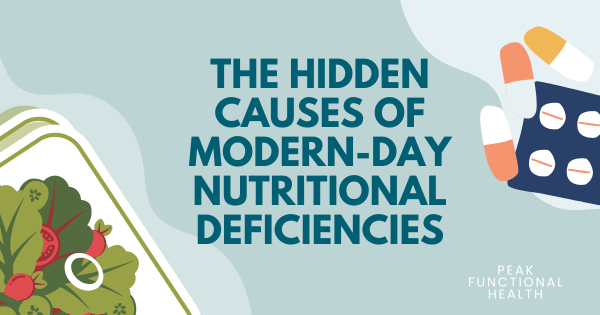The Hidden Causes of Modern-Day Nutritional Deficiencies

When we think of nutritional deficiencies, we often imagine rare, textbook cases—scurvy from a lack of vitamin C or rickets from inadequate vitamin D. But in reality, deficiencies often present far earlier and more subtly, long before reaching a clinical stage. These “hidden hungers” can quietly compromise the body’s ability to function, repair, and perform properly. So after we’ve addressed the non-negotiables of sleep, poop, and blood sugar balance, we turn our attention to creating a strong internal infrastructure to support healing. Without nutritional sufficiency, the body simply doesn’t have what it needs to rebuild.
What Does It Mean to Be Nutritionally Deficient?
Nutritional deficiencies aren’t limited to just low levels of vitamins. They can include macronutrients (like protein and healthy fats), micronutrients (such as magnesium or zinc), minerals, and phytonutrients—plant-based compounds that influence inflammation, detoxification, and immunity. Deficiency can also involve deeper biological factors such as low stomach acid, poor enzyme activity, impaired hormone production, or a lack of diversity in the gut microbiome.
In essence, a deficiency is anything the body should have in order to function well but doesn’t—either because it’s not getting it, not absorbing it, or not able to use it.
How Do Nutritional Deficiencies Develop?
Deficiencies don’t usually happen overnight. There’s often a progression, starting with depletion at the tissue level. Over time, the lack of available nutrients begins to impair enzyme function, which in turn affects digestion, energy production, detoxification, mood, and more. Eventually, symptoms appear as signals that something is off—fingernail ridges, discoloration in the whites of the eyes, delayed wound healing, or simply not feeling well. These are red flags that shouldn’t be dismissed as “normal.” They represent the critical middle ground between optimal health and full-blown pathology.
Several root causes contribute to this process:
Poor Dietary Intake: This is the most obvious and common contributor. Many people simply aren't eating enough nutrient-dense, whole foods. The Standard American Diet—high in processed foods and low in minerals and fiber—leaves many running on empty. Even healing diets, which may have worked for a time, can result in deficiencies if followed too long without variation or guidance.
Digestive Dysfunction: You are not what you eat, but what you absorb. Nutrient absorption can be hindered by low stomach acid, poor bile flow, pancreatic enzyme insufficiency, and imbalanced gut flora. Even if you’re eating well, you may not be extracting and utilizing the nutrients your body needs.
Chronic Stress: The physiological impacts of chronic stress are profound. Stress redirects blood flow away from the digestive tract, impairs stomach acid production, and taxes adrenal function—indirectly reducing nutrient absorption and increasing nutrient demand.
Medication Use: Common medications like antacids, proton-pump inhibitors (PPIs), antibiotics, birth control pills, and even metformin can interfere with nutrient levels, sometimes drastically. Long-term use without nutritional support can lead to downstream deficiencies.
Toxin Burden and Detox Demands: Detoxification is a nutrient-intensive process. The liver, immune system, and even your cells require a wide array of vitamins, minerals, and antioxidants to eliminate toxins effectively. When those nutrients are lacking, detox slows—and toxins can begin to recirculate, creating additional damage and inflammation.
Inflammation and Infection: Chronic inflammation and hidden infections increase the body’s nutrient needs and impair how well nutrients are absorbed and used. This includes underlying gut infections, hidden food sensitivities, parasitic burdens, and dysbiosis (microbial imbalance).
Absorption Blockers: Some foods contain compounds that bind minerals and block their absorption—like phytates and oxalates found in certain whole foods. These "anti-nutrients" can interfere with nutrient availability. While these foods aren’t inherently bad, they should be balanced with proper preparation techniques and an overall diverse diet.
How Can We Identify Nutritional Deficiencies?
You don’t always need lab tests to recognize a deficiency. Listening to the body—through symptoms and client history—can provide powerful insights. For example, seeing undigested food in stool may signal poor enzyme output or low stomach acid. Persistent fatigue might suggest B-vitamin insufficiency, while muscle cramps could indicate low magnesium or potassium.
In some cases, labs can help clarify or document a deficiency at a specific point in time. But they aren’t always straightforward. For instance, a low B12 level might prompt B-vitamin supplementation or increased red meat intake, but the issue may actually be poor absorption—not low intake. Knowing how to interpret labs in the context of function is key.
From Deficiency to Sufficiency: What It Takes
Restoring sufficiency means removing the blocks to absorption and rebuilding the body’s reserves through food, supplementation, and lifestyle changes. Nutrient-dense whole foods should always be the foundation, with targeted supplements used strategically based on individual needs. Supporting digestion—through hydration, thorough chewing, and stomach acid or enzyme support—can greatly improve absorption. And addressing stress, gut health, and inflammation ensures that what you consume is actually put to use.
The road to healing often begins with restoring what’s missing. The symptoms that bring people to functional nutrition—fatigue, hormonal imbalance, anxiety, digestive distress—often reflect a body trying to do its best with too little. When we move from deficiency to sufficiency, we give the body the building blocks it needs to repair, regenerate, and thrive.
At Peak Functional Health, we specialize in helping people make lasting changes that support the body’s natural healing processes. If you need additional support, guidance, or accountability, we’re here to walk you through the process—one step at a time.
Stay in touch!
Subscribe to our newsletter for periodic updates, special offers, and education!
Thank you for subscribing!
Have a great day!